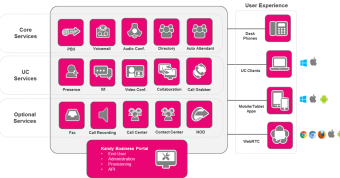From The Applications Layer to Development Platforms and “Outcomes-as-a-Service”
With billions of dollars being directed toward the virtualization of network functions through more sophisticated and scalable software solutions, making the processing and management of sessions increasingly efficient, and real-time communications more profitable – where is the real upside for service providers and enterprises going forward?
“Software everywhere” is driving creativity on the applications layer to new heights, and the design, development, testing and even distribution of real-time voice, data and video applications is becoming easier to do and faster to bring to market on a new generation of developer platforms. “Cracking the code” is not nearly as hard as it used to be when the ecosystem comes together to adopt standards (like WebRTC, ORTC and other over-the-top technologies) and use APIs, SDKs, libraries and quick starts that work on any IP-endpoint registered to the service.
Productivity improves, and businesses perform better, for example, when starting a voice call or video collaboration session is as easy as one touch or swipe from a social networking application – instead of dialing a number or bridge, one can initiate a peer-to-peer or multi-party session simply by being a subscriber of a service that uses a browser interface to “start connecting.”
The applications layer is ripe for further software innovation with the cloud and the separation of platforms with software APIs and SDKs enabling software developers to innovate and create highly productive applications, integrating real-time communications with real business workflows for greater productivity and business outcomes – and so we see in the future, not only incredible deep and scalable “platforms-as-a-service” but tangible “outcomes-as-a-service” when the applications being deployed and used also harness data – big data – that enables a healthcare organization, for example, to track and analyze how human communications is literally improving things like patient care, satisfaction and cost containment.
GENBAND just launched Kandy, a developers platform that bridges telco and the Web, and makes it possible for service providers and enterprises to build the RTC applications quickly and with substantially less risk than having to develop and test the software themselves. We have intentionally focused on “outcomes as a service” as we have always been all about helping our customers be successful, even as their networks and businesses continue to transform.
We are helping the same large service providers, for example, with both their “NFV” strategies as well as their “next generation applications” solutions. They are developing everything from embedded communications in business systems (like CRM, ERP, HR, IT, customer service and Web) as well as building vertical market solutions in education, healthcare, government, logistics, hospitality and more.
The innovations we are enabling with our Session Grid framework that I discussed in Part One of this blog and the Kandy platform are not timid – they are radical applications that are substantially enhancing the offer, and how they serve their consumer and business customers. We are bringing a huge wave of capabilities to channel partners as well, from our NUViA™ cloud to our Kandy platform, enabling them to replace traditional “voice” revenues with exciting new solutions their business customers crave.
Software runs throughout this “Blue Ocean” and its many streams. Our vision is a collective vision which we have harnessed over fifteen years serving the industry, and we cannot think of a more exciting time – than now.




